towing CHEVROLET ASTRO PASSENGER 1994 1.G Owners Manual
[x] Cancel search | Manufacturer: CHEVROLET, Model Year: 1994, Model line: ASTRO PASSENGER, Model: CHEVROLET ASTRO PASSENGER 1994 1.GPages: 340, PDF Size: 16.86 MB
Page 75 of 340
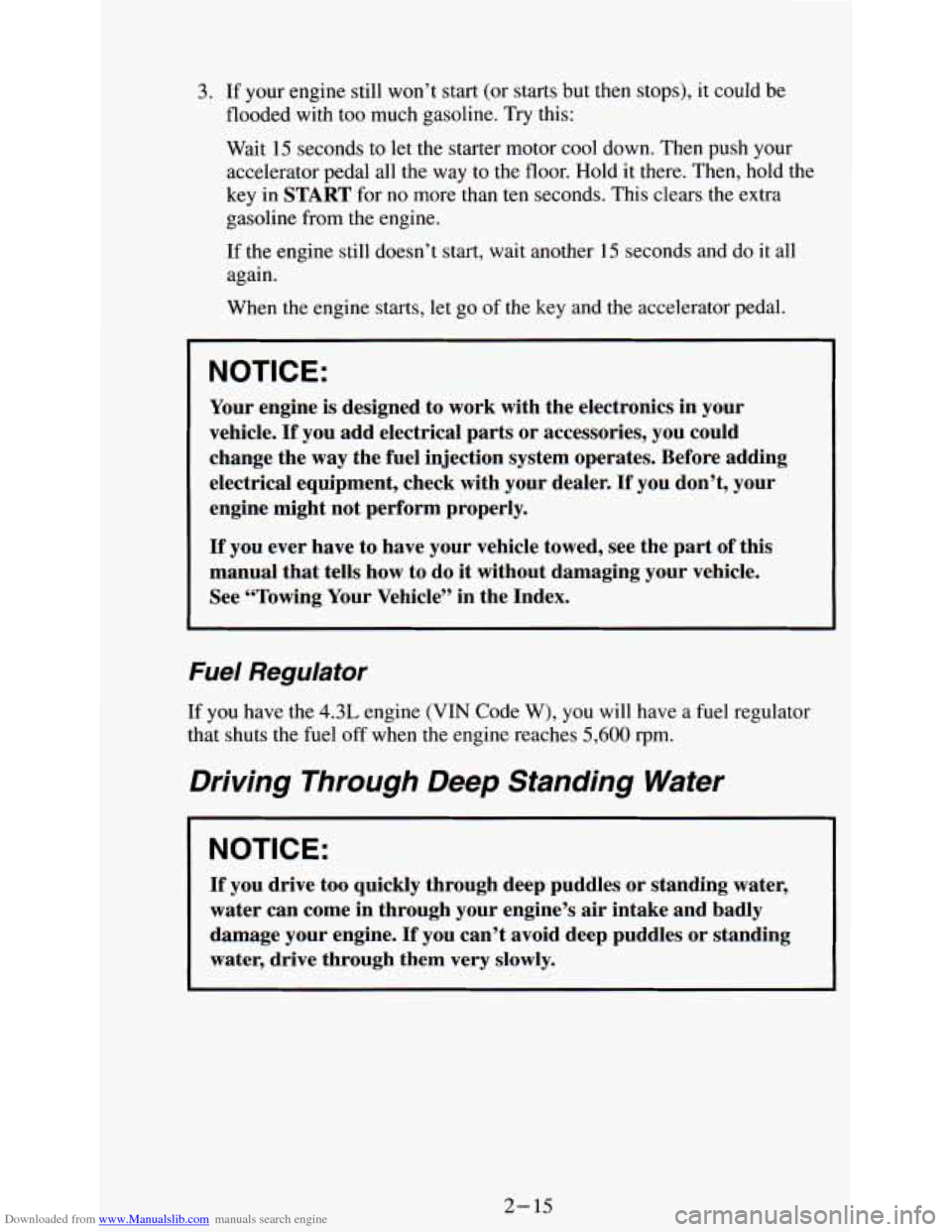
Downloaded from www.Manualslib.com manuals search engine 3. If your engine still won’t start (or starts but then stops), it could be
flooded with too much gasoline. Try this:
Wait 15 seconds to let the starter motor cool down. Then push your
accelerator pedal all the way to the floor. Hold it there. Then, hold the
key in
START for no more than ten seconds. This clears the extra
gasoline from the engine.
If the engine still doesn’t start, wait another 15 seconds and do it all
again.
When the engine starts, let go of the key and the accelerator pedal.
NOTICE:
Your engine is designed to work with the electronics in your
vehicle.
If you add electrical parts or accessories, you could
change the way the fuel injection system operates. Before adding
electrical equipment, check with your dealer.
If you don’t, your
engine might not perform properly.
If you ever have to have your vehicle towed, see the part of this
manual that tells how to do it without damaging your vehicle.
See “Towing Your Vehicle” in the Index.
Fuel Regulator
If you have the 4.3L engine (VIN Code W), you will have a fuel regulator
that shuts the fuel off
when the engine reaches 5,600 rpm.
Driving Through Deep Standing Water
NOTICE:
If you drive too quickly through deep puddles or standing water,
water can come in through your engine’s air intake and badly
damage your engine.
If you can’t avoid deep puddles or standing
water, drive through them very slowly.
2- 15
Page 79 of 340
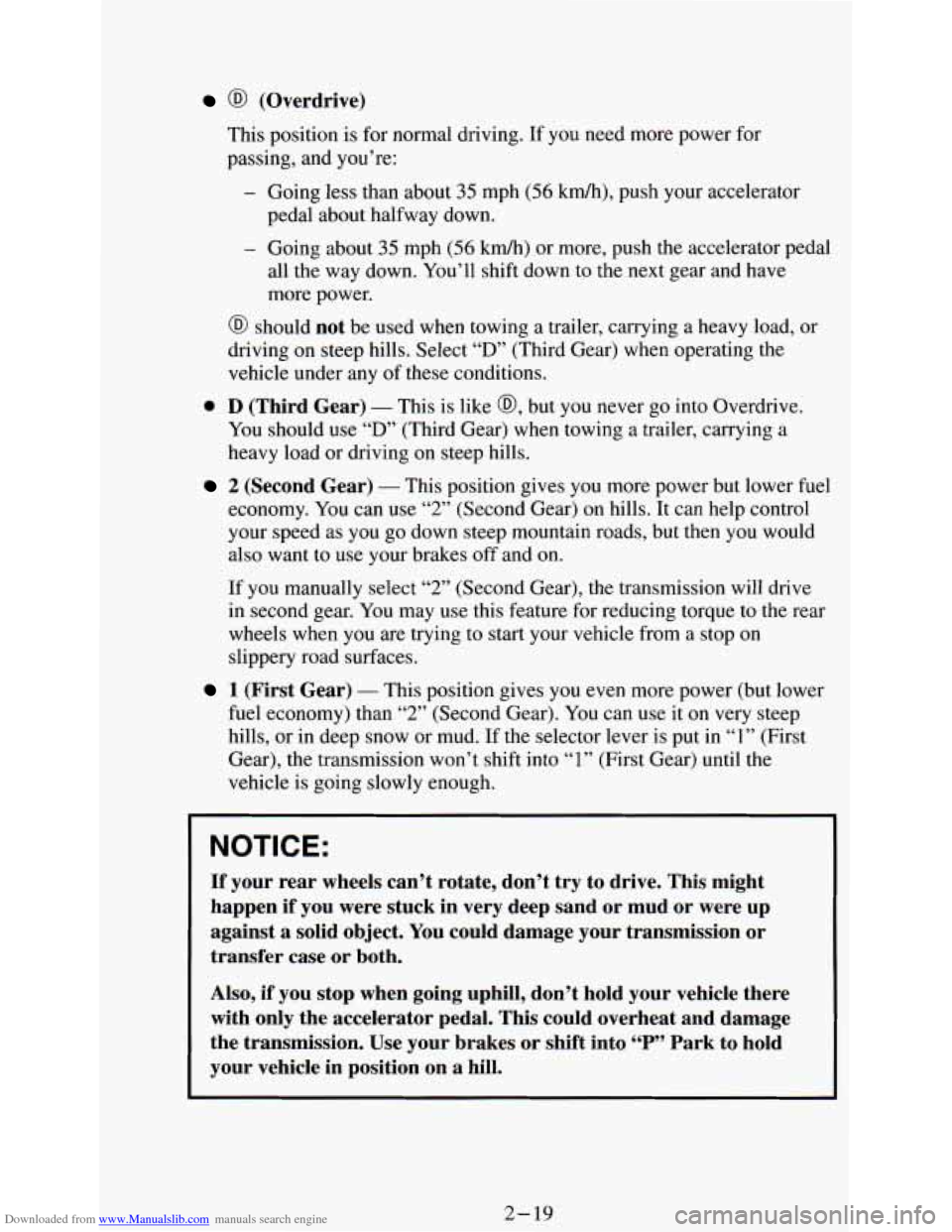
Downloaded from www.Manualslib.com manuals search engine @ (Overdrive)
This position is for normal driving. If you need more power for
passing, and you’re:
- Going less than about 35 mph (56 kdh), push your accelerator
- Going about 35 mph (56 kdh) or more, push the accelerator pedal
pedal
about halfway down.
all the way down. You’ll shift down to the
next gear and have
more power.
@ should not be used when towing a trailer, carrying a heavy load, or
driving on steep hills. Select
“D” (Third Gear) when operating the
vehicle under any of these conditions.
0 D (Third Gear) - This is like @, but you never go into Overdrive.
You should use
“D’ (Third Gear) when towing a trailer, carrying a
heavy load or driving on steep hills.
2 (Second Gear) - This position gives you more power but lower fuel
economy. You can use
“2” (Second Gear) on hills. It can help control
your speed as you go down steep mountain roads, but then you would
also want to use your brakes off and on.
If you manually select
“2” (Second Gear), the transmission will drive
in second gear. You may use this feature for reducing torque to the rear
wheels when you are trying to start your vehicle from a stop on
slippery road surfaces.
1 (First Gear) - This position gives you even more power (but lower
fuel economy) than
“2” (Second Gear). You can use it on very steep
hills, or in deep snow or mud. If the selector lever is put in
“1” (First
Gear), the transmission won’t shift into
“1” (First Gear) until the
vehicle is going slowly enough.
NOTICE:
If your rear wheels can’t rotate, don’t try to drive. This might
happen if you were stuck in very deep sand or mud or were up
against
a solid object. You could damage your transmission or
transfer case or both.
Also, if you stop when going uphill, don’t hold your vehicle there
with only the accelerator pedal. This could overheat and damage
the transmission. Use your brakes or shift into
“P” Park to hold
your vehicle in position on
a hill.
2-19
Page 81 of 340
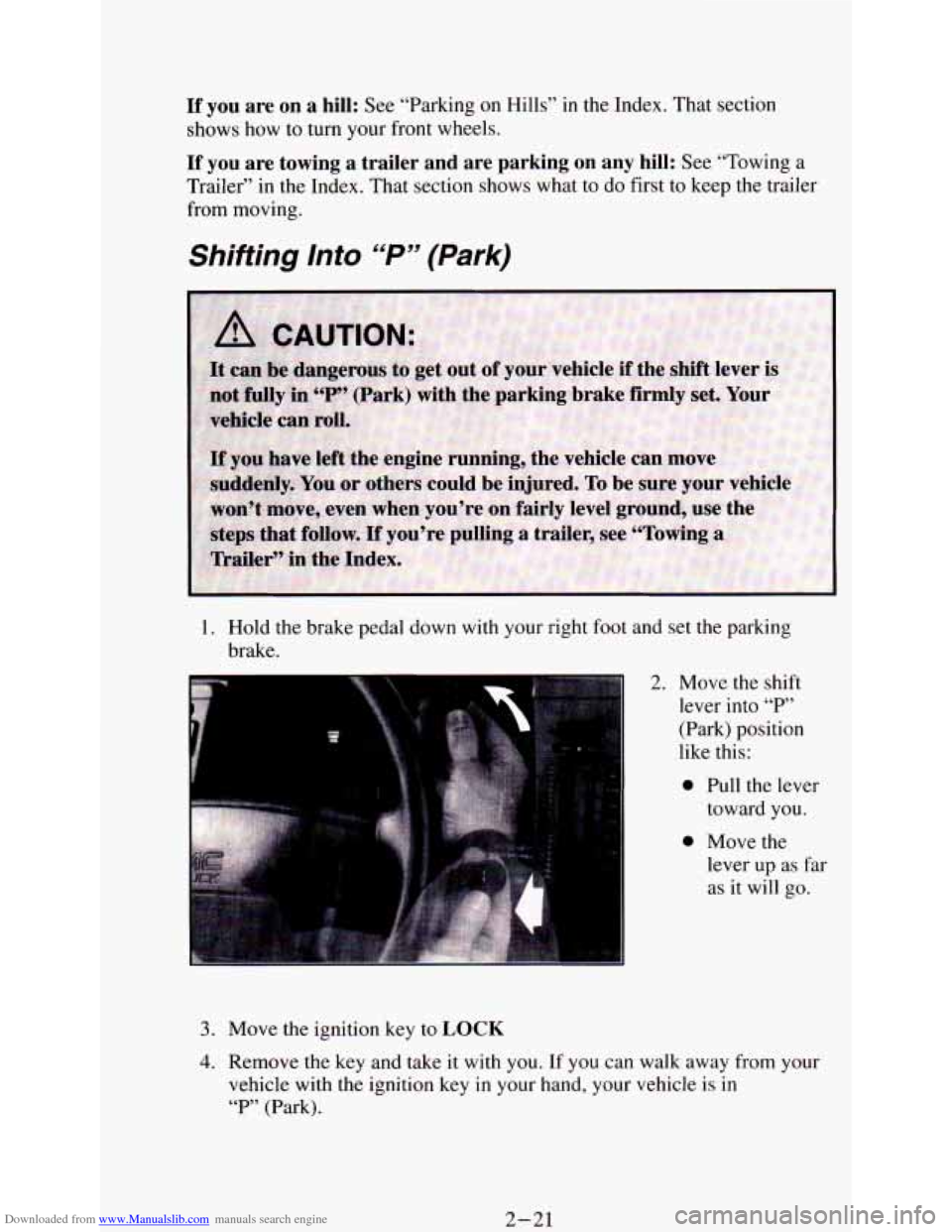
Downloaded from www.Manualslib.com manuals search engine If you are on a hill: See “Parking on Hills” in the Index. That section
shows how to turn your front wheels.
If you are towing a trailer and are parking on any hill: See “Towing a
Trailer” in the Index. That section shows what to do first to keep the trailer
from moving.
Shifting lnto “Pyy (Park)
1. Hold the brake pedal down with your right foot and set the parking
brake.
3. Move the ignition key to LOCK
2. Move the shift
lever into
“P’
(Park) position
like this:
0 Pull the lever
toward you.
0 Move the
lever up
as far
as it will go.
4. Remove the key and take it with you. If you can walk away from your
vehicle with the ignition key
in your hand, your vehicle is in
“P” (Park).
2-21
Page 85 of 340
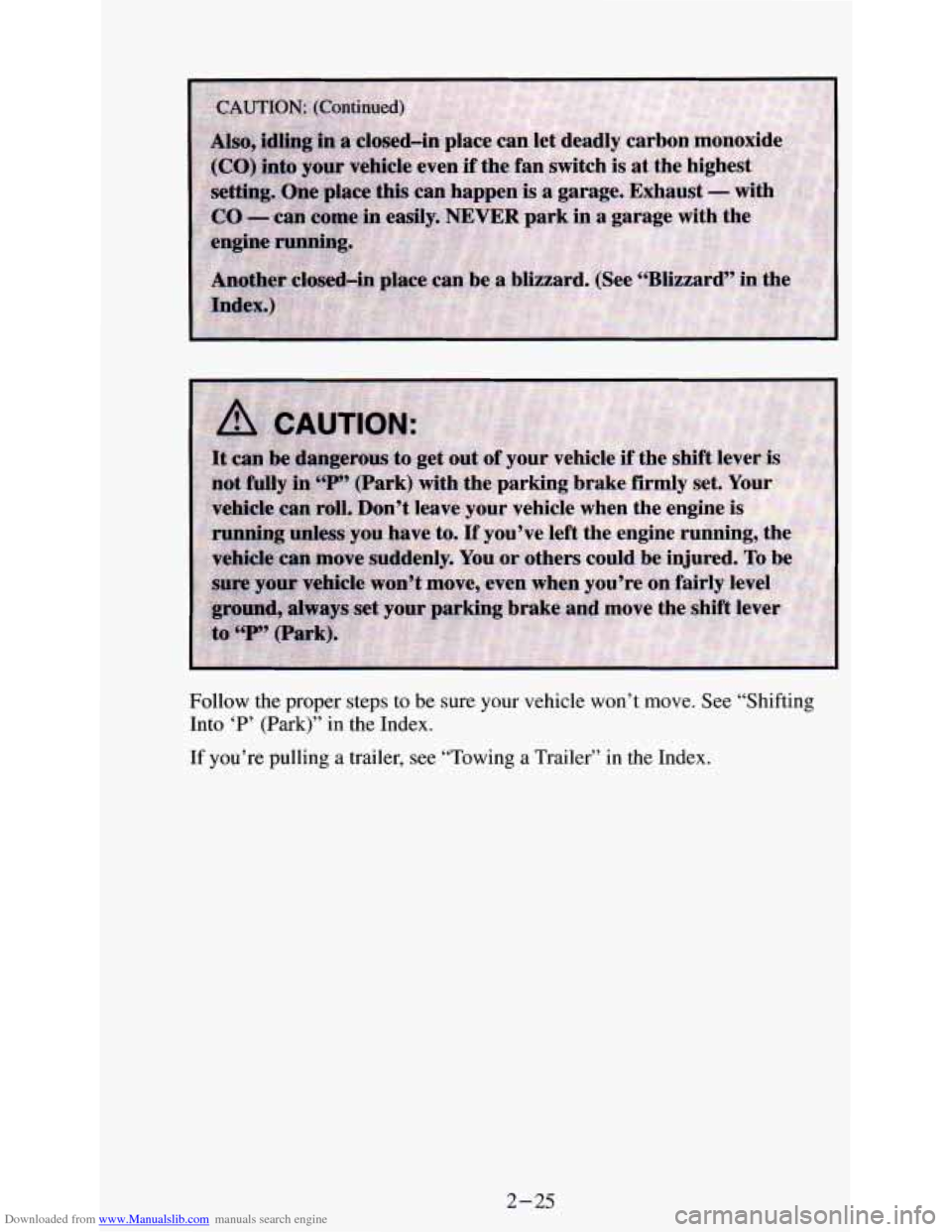
Downloaded from www.Manualslib.com manuals search engine Follow the proper steps to be sure your vehicle won’t move. See “Shifting
Into
‘P’ (Park)” in the Index.
If you’re pulling
a trailer, see “Towing a Trailer” in the Index.
2-25
Page 91 of 340
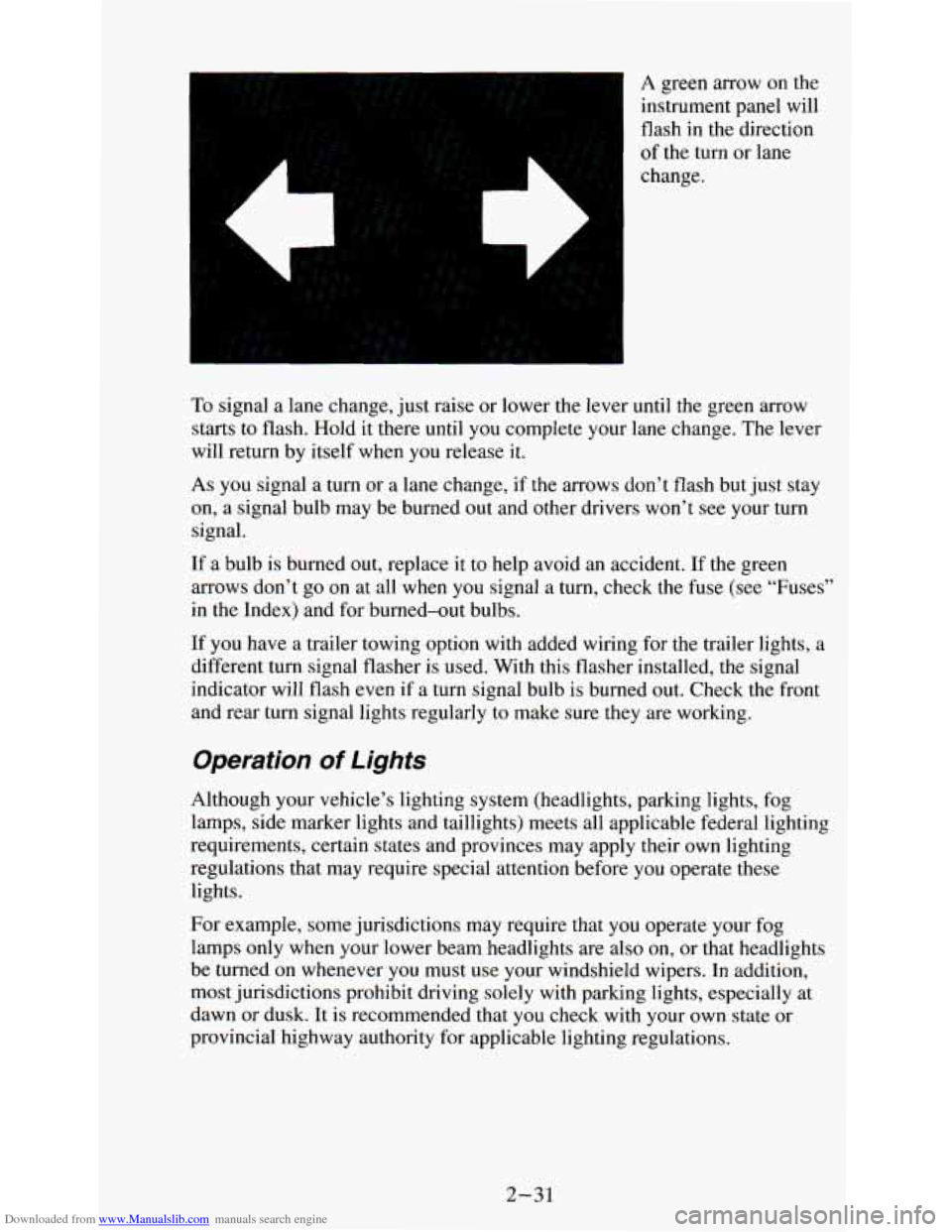
Downloaded from www.Manualslib.com manuals search engine ‘I
I
A green arrow on the
instrument panel will
flash in the direction
of the turn or lane
change.
To signal a lane change, just raise or lower the lever until the green arrow
starts to flash. Hold it there until
you complete your lane change. The lever
will return by itself when
you release it.
As you signal a turn or a lane change, if the arrows don’t flash but just stay
on, a signal bulb may be burned out and other drivers won’t
see your turn
signal.
If a bulb is burned out, replace it to help avoid an accident. If the green
arrows don’t go
on at all when you signal a turn, check the fuse (see “Fuses”
in the Index) and for burned-out bulbs.
If you have a trailer towing option with added wiring for the trailer lights, a
different turn signal flasher is used. With this flasher installed, the signal
indicator will flash even if a turn signal bulb is burned out. Check the front
and rear turn signal lights regularly to make sure they are working.
Operation of Lights
Although your vehicle’s lighting system (headlights, parking lights, fog
lamps, side marker lights and taillights) meets all applicable federal lighting
requirements, certain states and provinces may apply their own lighting
regulations that may require special attention before you operate these
lights.
For example, some jurisdictions may require that you operate your fog
lamps only when your lower beam headlights are also
on, or that headlights
be turned
on whenever you must use your windshield wipers. In addition,
most jurisdictions prohibit driving solely with parking lights, especially at
dawn or dusk. It is recommended that you check with your own state or
provincial highway authority for applicable lighting regulations.
2-31
Page 116 of 340
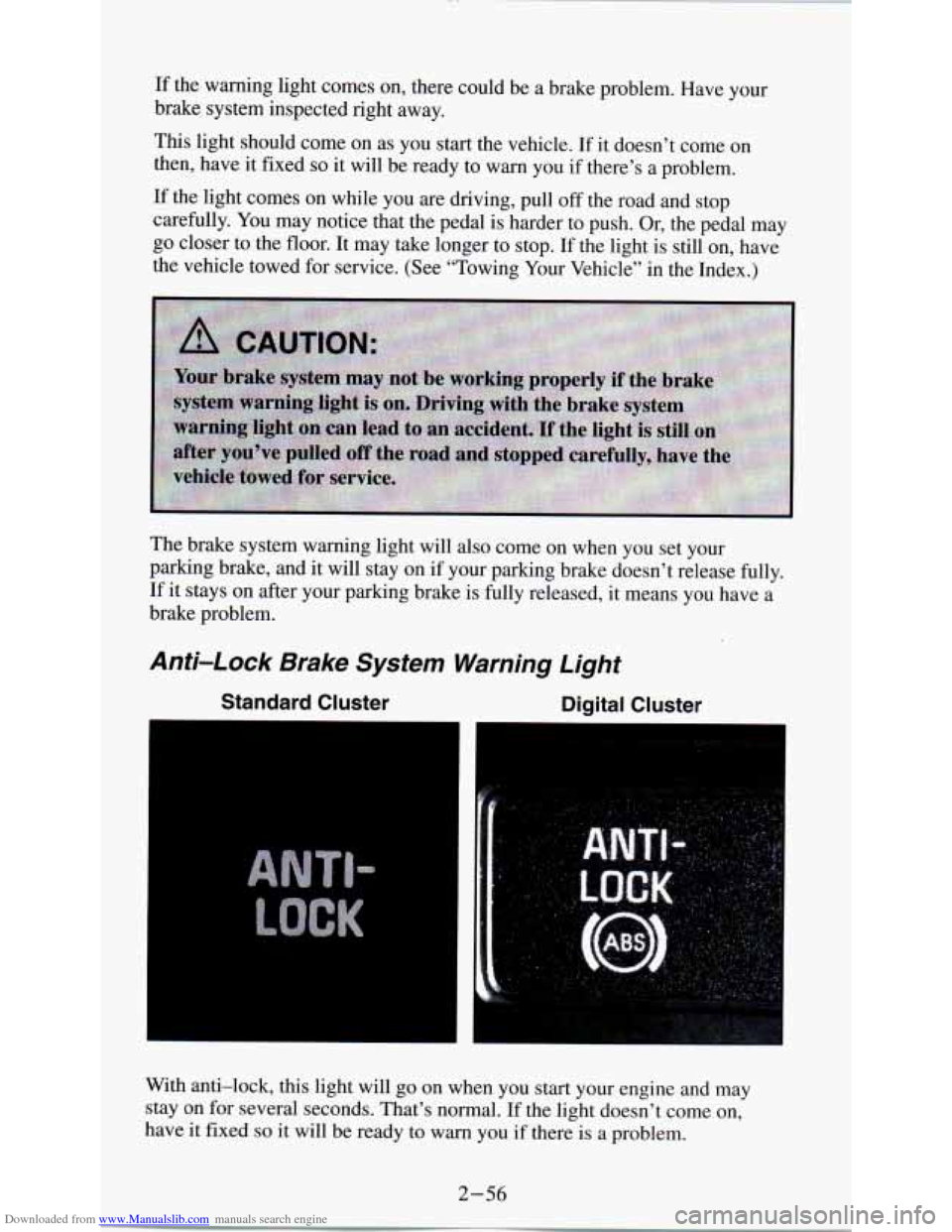
Downloaded from www.Manualslib.com manuals search engine If the warning light comes on, there could be a brake problem. Have your
brake system inspected right away.
This light should come on as you start the vehicle. If it doesn’t come on
then, have it fixed
so it will be ready to warn you if there’s a problem.
If the light comes on while you are driving, pull off the road and stop
carefully. You may notice that the pedal is harder to push.
Or, the pedal may
go closer to the floor. It may take longer to stop. If the light is still
on, have
the vehicle towed for service. (See “Towing Your Vehicle” in the Index.)
The brake system warning light will also come on when
YOU set your
parking brake, and it will stay on
if your parking brake doesn’t release fully.
If it stays on after your parking brake is fully released, it means YOU have a
brake problem.
Anti-Lock Brake System Warning Light
Standard Cluster Digital Cluster
I
With anti-lock, this light will go on when you start your engine and may
stay on for several seconds. That’s normal. If the light doesn’t come on,
have it fixed
so it will be ready to warn you if there is a problem.
2-56
Page 155 of 340
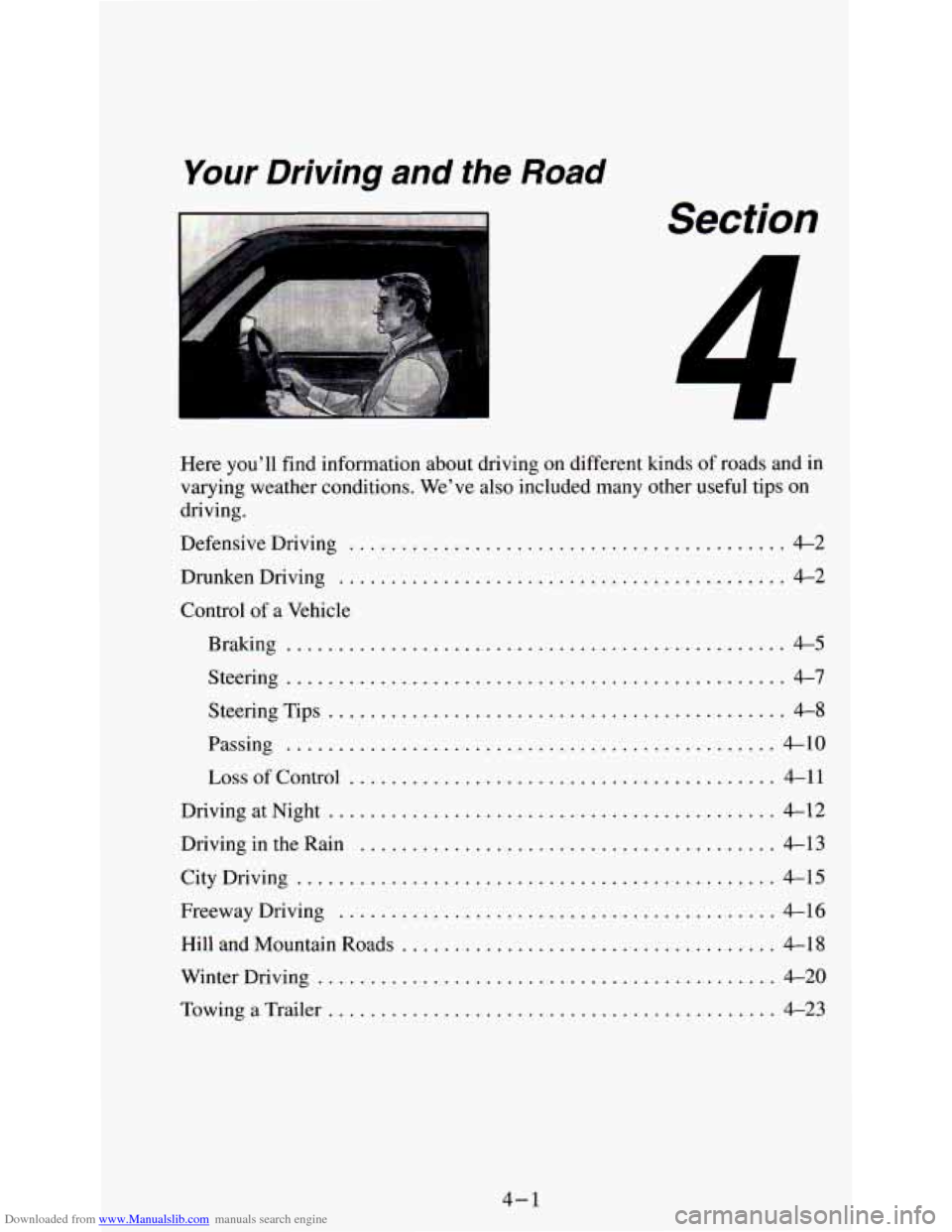
Downloaded from www.Manualslib.com manuals search engine Your Driving and the Road
Section
.......
--_-. ~ ~ - - ~ - - - -. . 4-2
...................... 4-2
Here
you’ll find information about driving on different kinds of roads and in
varying weather conditions. We’ve also included many other useful tips on
driving.
Defensive Driving
...
Drunken Driving . I
Control of a Vehicle
Braking
.............................................. 4-5
Steering
................................................ 4-7
Steering Tips .............. .................... 4-8
Passing ............................................... 4-10
Loss of Control ..... .......... 4-11
Driving at Night
......... ........ 4-12
Driving in the Rain
........................................ 4-13
CityDriving
............................................ 4-15
Freeway Driving
............... ........... ...... 4-16
Winter Driving
................. ......... ...... 4-20
TowingaTrailer
........................................... 4-23
Hill and
Mountain Roads
.................................. 4-1 8
......................
................
4-1
Page 177 of 340
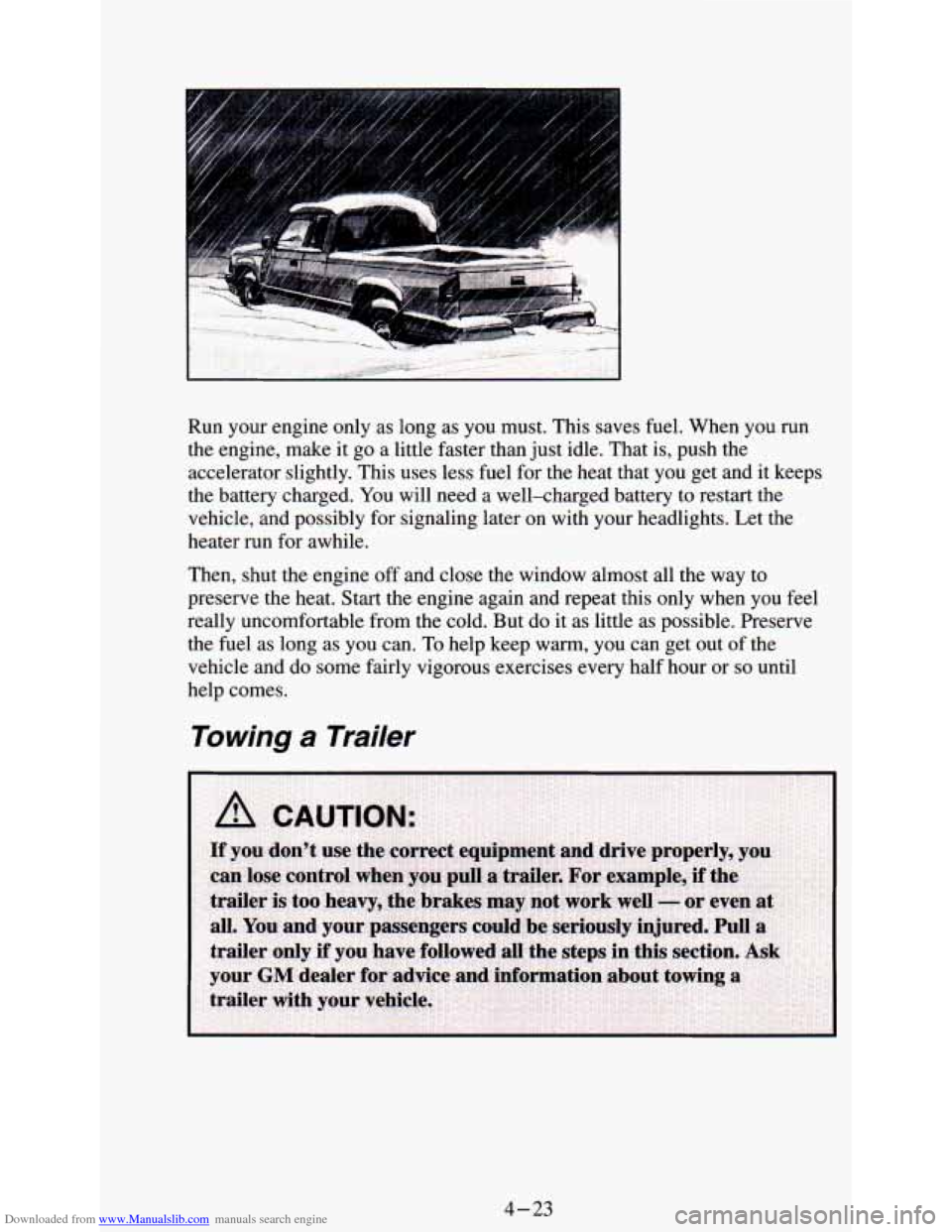
Downloaded from www.Manualslib.com manuals search engine Run your engine only as long as you must. This saves fuel. When you run
the engine, make it go a little faster than just idle. That is, push the
accelerator slightly. This uses less fuel for the heat that you get and it keeps
the battery charged. You will need a well-charged battery to restart the
vehicle, and possibly for signaling later on with your headlights. Let the
heater
run for awhile.
Then, shut the engine off and close the window almost all the way to
preserve the heat. Start the engine again and repeat this only when you feel
really uncomfortable from the cold. But do it as little as possible. Preserve
the
fuel as long as you can. To help keep warm, you can get out of the
vehicle and do some fairly vigorous exercises every half hour or
so until
help comes.
Towing a Trailer
4-23
Page 178 of 340
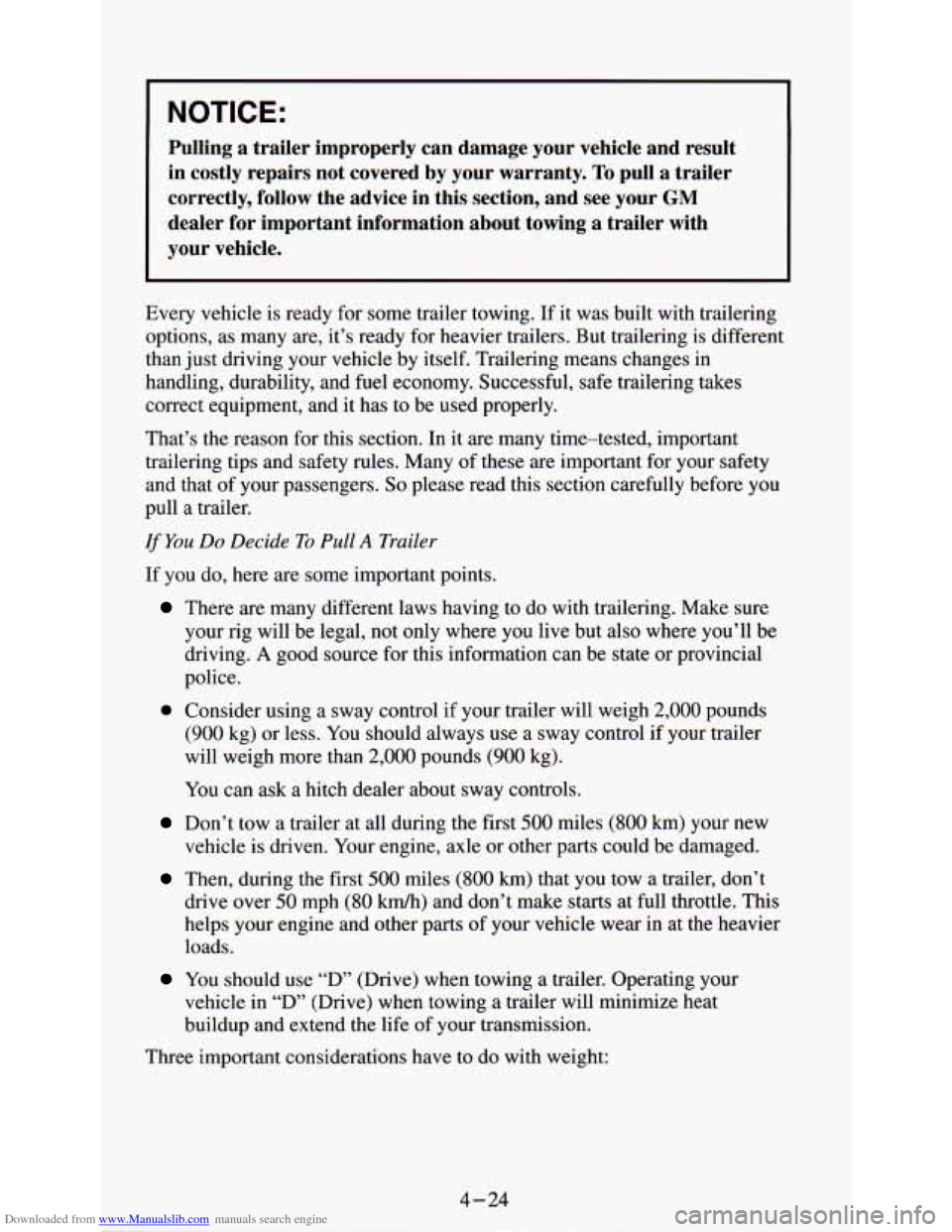
Downloaded from www.Manualslib.com manuals search engine NOTICE:
Pulling a trailer improperly can damage your vehicle and result\
in costly repairs not covered by your warranty.
To pull a trailer
correctly, follow the advice in this section, and see your
GM
dealer for important information about towing a trailer with
your vehicle.
Every vehicle is ready for some trailer towing. If it was built with trailering
options, as many are, it’s ready for heavier trailers. But trailering is different
than just driving your vehicle by itself. Trailering means changes in
handling, durability, and fuel economy. Successful, safe trailering takes
correct equipment, and it has to be used properly.
That’s the reason for this section. In it are many time-tested, important
trailering tips and safety rules. Many of these are important for your safety
and that of your passengers.
So please read this section carefully before you
pull a trailer.
If You Do Decide To Pull A Trailer
If you do, here are some important points.
There are many different laws having to do with trailering. Make sure
your rig will be legal, not only where you live but also where you’ll be
driving.
A good source for this information can be state or provincial
police.
0 Consider using a sway control if your trailer will weigh 2,000 pounds
(900 kg) or less. You should always use a sway control if your trailer
will weigh more than
2,000 pounds (900 kg).
You can ask a hitch dealer about sway controls.
Don’t tow a trailer at all during the first 500 miles (800 km) your new
vehicle is driven. Your engine, axle or other parts could be damaged.
Then, during the first 500 miles (800 km) that you tow a trailer, don’t
drive over
50 mph (80 kmh) and don’t make starts at full throttle. This
helps your engine and other parts of your vehicle wear in at the heavier
loads.
You should use “D” (Drive) when towing a trailer. Operating your
vehicle in “D” (Drive) when towing a trailer will minimize heat
buildup and extend the life of
your transmission.
Three important considerations have to do with weight:
Page 181 of 340
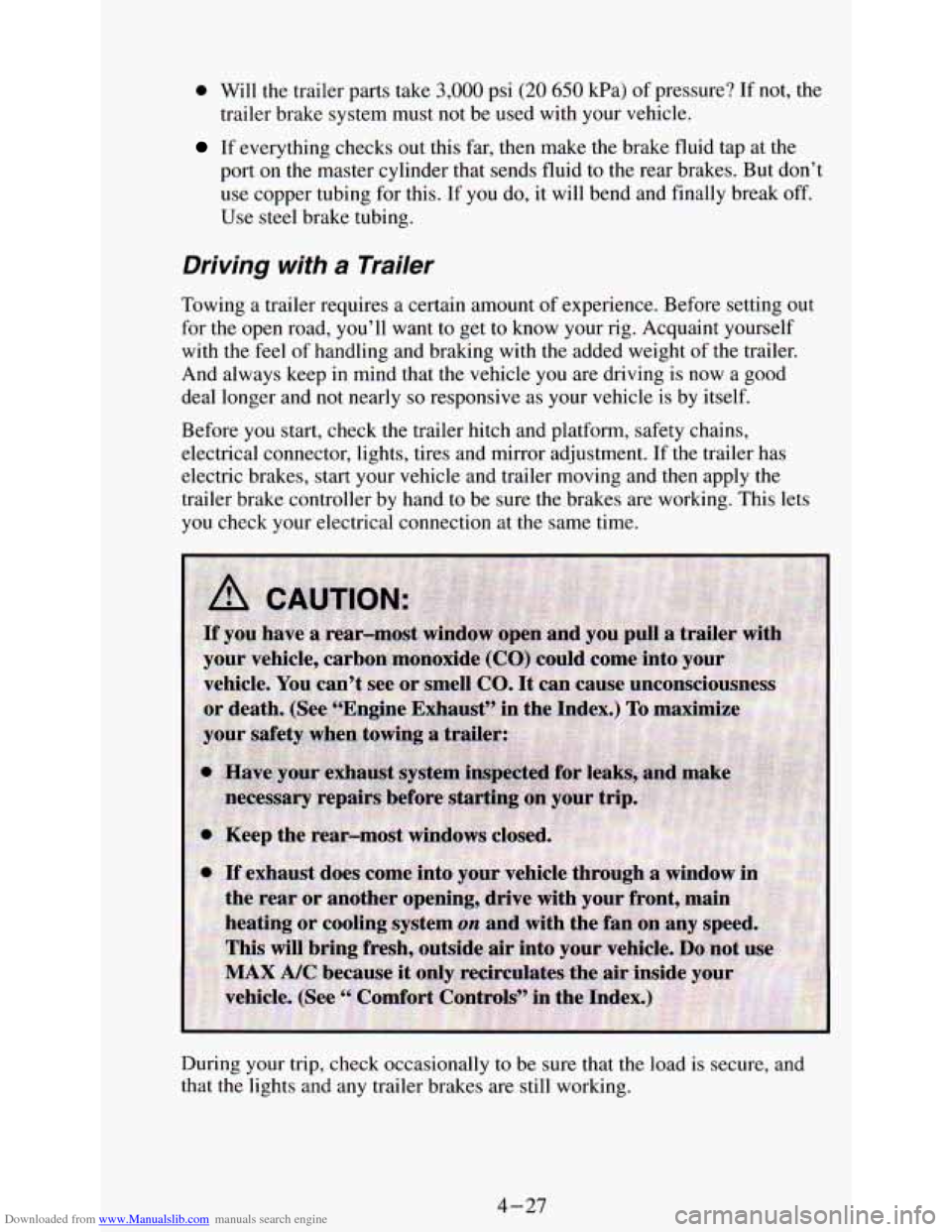
Downloaded from www.Manualslib.com manuals search engine 0 Will the trailer parts take 3,000 psi (20 650 kPa) of pressure? If not, the
trailer brake system must not be used with your vehicle.
If everything checks out this far, then make the brake fluid tap at the
port
on the master cylinder that sends fluid to the rear brakes. But don’t
use copper tubing for this.
If you do, it will bend and finally break off.
Use steel brake tubing.
Driving with a Trailer
Towing a trailer requires a certain amount of experience. Before setting out
for the open road, you’ll want to get to know your rig. Acquaint yourself
with the feel
of handling and braking with the added weight of the trailer.
And always keep in mind that the vehicle you are driving is now a good
deal longer and not nearly
so responsive as your vehicle is by itself.
Before you start, check the trailer hitch and platform, safety chains,
electrical connector, lights, tires and mirror adjustment. If the trailer has
electric brakes, start your vehicle and trailer moving and then apply t\
he
trailer brake controller by hand to be sure the brakes are working. This lets
you check your electrical connection at the same time.
During your trip, check occasionally to be sure that the load is secure, and
that the lights and any trailer brakes are still working.
4-27